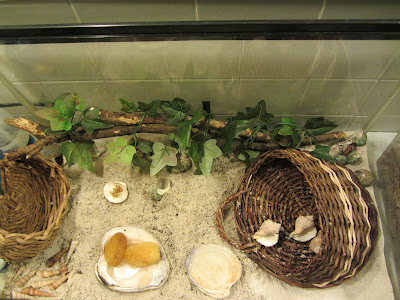
I took the lids off our crab habitats or "crabitats" so I could take a few pictures and post some updates about our new pets. Norah has been reading all about hermit crabs and so she and I have thrown ourselves into making the nicest homes we can for them, according to all we are reading in the books.
We are using many of the shells Norah already had in her shell "collection." The big clam shell Norah found while we were on vacation last summer had separated and the two sides of that shell make perfect water dishes, actually. You can see one of the sides of the clam shell in the photo above with sponges in it. (The sponges absorb lots of extra water and help keep the humidity in the tank up.) Other, smaller shells in Norah's collection have also been perfect for salt water dishes, food dishes and just for general decoration.
We also got a larger tank and a tank heater for free off Craiglist. We purchased (really overpriced) sand, extra hermit shells and a tank lid at the pet store. But we also found several extra hermit shells and baskets at the thrift store. The baskets allow the crabs places to hide and offer them things to climb. (We boiled everything we could to kill any bacteria and let it air dry and cool off before we added to the tank with the crabs.)
You can see one of our crabs in the photo below. This crab was actually in a painted yellow shell when we first brought our crabs home. His (or her) name is "Molly." (We don't know the sex of the crabs yet.) As you can see in the top picture, we laid a bunch of extra hermit shells similar to the one he was already in all around the big tank. He didn't show any signs of molting, but overnight, he decided to move to a bigger, more natural looking shell. Norah read that crabs prefer natural shells to painted shells when given a choice. Since then, we've see him sticking his head into other shells and feeling around with his claws. He is seeming to consider those shells as well, so it's possible that he may move shells again.

We also collected some maple branches from under our tree in the yard. It happens to be the perfect time of year to find dead tree branches just lying around. I baked them in the oven at 300 degrees for 45 minutes. According to one of Norah's books, maple is a wood that is supposed to be safe for crabs as long as you bake it to kill any parasites before putting it in your crabitat. I also purchased a plastic vine from the dollar store that we knotted and wrapped around the maple branches once they cooled. Norah says that these crabs are also called "tree crabs" since they are so often found in trees in the wild so we will see if our crabs like to climb, too.
One of our two crabs, "Shiny," started showing signs that he was definitely thinking about molting last week, so we separated him from the other crab just as Norah's books say to do. He quickly disappeared under the sand for at least four days... Norah and I lost count. He is still in that separate, smaller tank (pictured below.) As you can see, we are offering him several extra shells to choose from, too. He may want something bigger now that he has grown a little more. If you look closely, you can see part of the crab's silvery shell under the sand. He's buried himself between the other half of the large clam shell that we are using as a water dish on the left and the empty, green shell on the right. He comes up to drink and eat, so we think he might actually be done molting at this point. He also looks a lot smaller now and Norah says that she's read that crabs appear smaller after a molt. But, they are also more vulnerable after a molt until their new shell hardens, so we think that's why this crab may still be hiding under the sand for now.

We're so glad that our friends gave us their hermit crabs. Norah and I are really learning alot and enjoying every bit of it, too.



1 comment:
Wow! you have really learned a lot! My first crab, houdini, just died of dehydration, so make sure ou leave out plenty of fresh water for your crabs. Also, they need salt water to survive. They eat a variety of fruits and veggies, so experiment with different things to find what your crabs like. I am going out this weekend to buy more crabs, so that will be fun!
Post a Comment